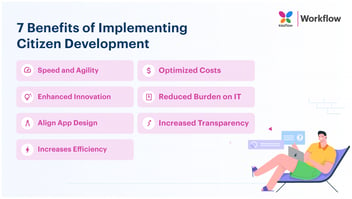Low-code platforms have become a go-to solution for enterprises looking to speed up digital transformation. They promise faster delivery, lower costs, and reduced dependency on traditional software development cycles. To accelerate this further, many companies bring in System Integrator (SI) teams to handle the build.
At first, it seems like the right call. SIs are experienced, reliable, and structured. But when it comes to medium-complexity apps, their approach can actually work against the very ROI that low-code platforms are supposed to deliver.
This is where IT leaders often face an invisible drain on resources: the hidden cost of using enterprise-scale development processes for medium-scale outcomes.
When heavy processes meet medium complexity
SI teams are built to handle large, mission-critical programs. They excel at complex architecture, governance frameworks, and layered project management. However, medium-complexity apps, such as department-level workflows approval systems, demand speed and flexibility rather than heavy documentation and formal sprint reviews.
When traditional SI methods are applied to these projects, costs and timelines quickly inflate. According to McKinsey, as much as 30–40% of project costs in typical SI engagements go into coordination, governance, and documentation rather than actual build work. For a $200,000 project, that could mean $80,000 spent purely on process.
In the context of low-code, this becomes redundant. The platform already simplifies complexity. Layering more structure on top only slows down outcomes.
The ROI equation that doesn’t add up
Low-code ROI is typically driven by speed, resource efficiency, and faster deployment. However, when SI teams take over mid-tier applications, those advantages can disappear.
|
Factor
|
Intended ROI Outcome
|
Real-world SI Impact
|
|
Delivery Time
|
Launch within weeks
|
Slips into multi-month timelines
|
|
Cost Efficiency
|
60–80% lower dev costs
|
Reduced savings due to high overhead
|
|
Agility
|
Quick iteration cycles
|
Slowed down by rigid governance
|
A Forrester study found that organizations using low-code effectively can achieve an ROI as high as 188 percent. But when the same platforms are managed through traditional SI processes, that figure drops drastically because much of the value is absorbed by management overhead and handoff inefficiencies.
Why internal IT or hybrid models work better
Medium-complexity apps perform best when owned by internal IT teams or through hybrid models where internal teams collaborate selectively with external experts.
Here’s why:
-
Faster iterations: Internal teams can make quick changes without layers of external approvals.
-
Better context: They understand internal workflows, compliance needs, and user behavior.
-
Lower costs: They leverage reusable low-code components and avoid over-engineering.
These teams combine business understanding with technical control, giving enterprises the true low-code ROI—more apps, in less time, with greater alignment to real needs.
The hidden waste no one talks about
Beyond visible costs, there’s another kind of loss: enterprise development waste.
This includes:
- Idle time between requirement clarification and sprint start.
- Rework due to minimal user involvement.
- Over-documentation that doesn’t add delivery value.
Such waste rarely appears in post-project reports but significantly impacts efficiency. A medium app that could have cost $50,000 internally can end up as a $200,000 SI project, with extended timelines and unclear accountability.
How Kissflow restores low-code ROI
Kissflow’s low-code platform helps IT leaders reclaim control over their app development process. It enables internal teams to build medium-complexity applications quickly, while still maintaining governance and scalability.
With Kissflow, teams can:
- Build applications through visual development tools.
- Collaborate seamlessly between business and IT.
- Deploy faster, reduce iterations, and track ROI transparently.
The platform eliminates inefficiencies that often arise from external dependencies, helping enterprises focus on results rather than process overhead.
Final thoughts
The ROI of low-code isn’t just about the platform; it’s about how it’s implemented. Medium-complexity apps don’t require the same level of rigor as full-scale enterprise programs. They require agility, ownership, and a model that prioritizes swift delivery over formal processes.
If your low-code initiatives feel slower or more expensive than expected, it may be time to review your execution model and shift towards one that maximizes value.
Build smarter, deliver faster
See how Kissflow helps IT leaders achieve higher ROI from their low-code investments.



